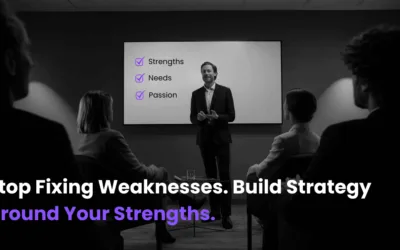My mornings don’t usually kick off with spreadsheets and data. Instead, they often start with a simple question: what truly matters right now? And not just to me, but to the people I’m trying to connect with, to influence, to help. Marketers, for as long as there have been marketers, have been churning out content, all aimed at grabbing attention. We focus on clicks, views, and engagement – and that’s not entirely wrong. But something’s changing. The sheer amount of stuff out there means our carefully made pieces often just get lost in the noise, a faint echo in a really crowded room.
The problem? We’ve gotten really good at making content, but maybe not so great at building truly original thoughts. We’re excellent at repeating what others are saying, or putting a new spin on old ideas. But genuine, standout thought leadership? That’s a whole different ball game. It’s what turns a business from just another vendor into an essential advisor, from a basic product into something that defines its whole category. If you’re a marketer feeling like your content isn’t hitting home anymore, or an executive wondering why your brand isn’t punching above its weight, this isn’t just a tough spot-it’s a real chance to completely rethink your impact.
The Signal-to-Noise Problem: Why Your Content Might Be Falling Flat
We live in a time when content is everywhere, but real, fresh insight feels rare. Think about it: every company has a blog, every executive has a LinkedIn profile, every industry has its share of “experts.” This ease of publishing, which sounds good on paper, has actually created a huge signal-to-noise problem. Brands are spending serious money on content marketing, yet a recent survey found that only 15% of B2B buyers thought leadership was “very good” or “excellent”. That’s a pretty big gap between what’s out there and what people actually value.
So, why does so much content marketing get lost in the shuffle?
- It’s often playing catch-up, not leading the way: We chase after trending topics instead of starting new conversations.
- It’s all too similar: Lots of voices are basically saying the same thing, just with slightly different words.
- It lacks original ideas: We just repeat existing data instead of finding new insights or doing our own research.
- It favours quantity over quality: The pressure to publish constantly often means we rush things, sacrificing depth for speed.
The alternative isn’t about ditching content marketing altogether. It’s about making it better, giving it a distinct perspective that positions your organisation – and its leaders – as truly authoritative voices that genuinely move an industry forward. And that means moving past just “content” and really focusing on developing compelling thought leadership.
The Leap: From Content Marketing to Thought Leadership
The journey from simply doing content marketing to truly leading with your thoughts isn’t just a small step; it’s a big, strategic jump. Making this shift means tackling four key challenges that often trip up organisations. Oxford Economics pointed these out in a recent report, and they give us a solid framework to work with:
Challenge 1: The “What to Say” Puzzle – Finding Your Unique Angle
For many, the biggest hurdle is just figuring out what unique perspective they can offer. If everyone’s talking about AI, how do you talk about AI in a way that feels fresh and truly informed?
You don’t need to disagree with the vast majority – or the direction of the industry – just to be different, but if you have a deep, evidence-backed belief that questions common wisdom or brings a hidden truth to light, then that’s a road worth travelling.
How to get past it:
- Dig into Your Core Strengths: What does your business really do better than anyone else, and why? What unique data do you have? What specific problems do you solve that others just sort of handle? Your unique viewpoint often comes straight from your real-world innovation and experience.
- Look for Overlooked Groups or Unasked Questions: Who’s being left out of the conversation? What crucial questions is your industry not asking because they’re too hard or uncomfortable? A Momentum ABM study found that 49% of senior leaders and decision makers prefer thought leadership that explores issues from fresh perspectives with provocative opinions. But 43% indicate most thought leadership is unoriginal.
- Don’t Be Afraid to Take a Stand: Thought leadership isn’t just neutral. It has a definite perspective (or should), and it isn’t scared to say it clearly, backed up by facts and good reasons. This might mean challenging a widely accepted idea, even if it feels a little uncomfortable at first.
Challenge 2: The “Who Should Speak” Question – Growing Your Own Internal Voices
Too often, thought leadership gets handed off to the marketing team. While marketers are vital for spreading messages, real thought leadership needs to come from the actual experts – the engineers, the executives, the product innovators. These are the people with the deep knowledge, but they’re often too swamped or just don’t have the training to express their ideas effectively.
How to get past it:
- Empower and Equip: Offer training in communication, storytelling, and dealing with the media for your internal experts. Don’t expect them to be natural writers or speakers from day one. Give them the tools, guidance, and time they need.
- Team Up Across Departments: Create programs that pair marketing people with technical experts. The marketer helps fine-tune the message and makes sure it connects with the right audience, while the expert ensures it’s accurate and deep. After all, agency copywriters often work with designers and other collaborators for a reason. Create that reason.
- Lead by Example: When top management actively participates in thought leadership, it shows everyone how important it is and encourages others to step up. McKinsey’s success, for instance, partly comes from its partners consistently publishing their own research and insights.
Challenge 3: The “Breaking Through” Problem – Spreading Your Ideas Beyond the Usual Places
Okay, you’ve got amazing insights, explained by brilliant people. Now what? Just posting it on your company blog isn’t enough anymore. The way you get your thought leadership out there needs to be as clever as the content itself.
How to get past it:
- Pick Your Channels Smartly: Beyond your own website, where do the leaders you want to reach get their information? Industry magazines? Specific podcasts? Niche online groups? Focus on landing your ideas in quality spots rather than just trying to get everywhere.
- Personalised Outreach: Thought leadership often calls for a more direct, personal touch. Find key influencers, journalists, and decision-makers, and connect with them directly, offering your insights as a valuable resource.
- Repurpose and Reformat Wisely: One central idea can turn into a detailed report, an executive summary, an infographic, a key speech at a conference, a LinkedIn article, and a series of social media posts. Each version should be tailored for its platform and audience, making your ideas go further and last longer. Technology can help here. One of my favourite technologies is Flowjin that can turn your long videos and podcasts into viral clips with AI.
Challenge 4: The “Proving It” Predicament – Measuring Long-Term Influence
Unlike direct marketing, thought leadership doesn’t always show an immediate return on investment. It’s a marathon, built on reputation, trust, and influence. Measuring its impact can be tricky, but it’s definitely not impossible.
How to get past it:
- Focus on Influence Metrics: Keep an eye on mentions in industry publications, invitations to speak at important events, citations by other thought leaders, and any shifts in how your audience feels or perceives things.
- Get Qualitative Feedback: Do surveys or interviews with target executives to understand if your thought leadership is really changing their minds or affecting their decisions. Are they bringing up your ideas in their own meetings?
- Connect to Business Goals: Even if it’s indirect, thought leadership should ultimately help with brand reputation, getting new leads, speeding up sales, and attracting talent. Watch these longer-term indicators over time, understanding that the connection might be complex and take a while to show.
The Higher Conversation: Why This Matters More Than Ever
We’re not just selling products or services anymore; we’re selling a vision for the future, a way of thinking, a better approach to things. In a world drowning in data, your business needs to become a go-to source for real guidance, not just another supplier of content.
This shift isn’t easy. It demands commitment from leadership, investment in smart ideas, and a company culture willing to question and innovate. But it’s the difference between merely existing in the market and actually shaping it. It’s how you break free from the content echo chamber and turn your business into a true industry leader – a voice that doesn’t just join the conversation, but actually starts it.
At Disruptors Co we believe in “innovation on purpose”. And part of that is telling powerful stories through thought leadership. ProPresence is our powerful platform that enables time-poor leaders to consistently show up as insightful, visible experts on LinkedIn. Check it out for a 14 day free trial.



